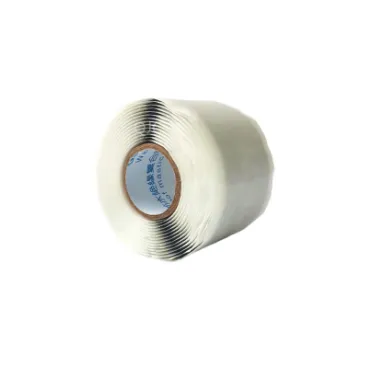In electrical systems where safety and performance are critical, the right insulation can make all the difference. That’s where high voltage electrical tape comes in. Designed to insulate, seal, and protect in extreme conditions, this tape is engineered to handle much more than the standard household voltage. Whether you're a utility technician, industrial contractor, or electrical distributor, understanding the value of high voltage tape and its companion product, splicing tape, is key to maintaining safe, reliable systems.

This guide breaks down what makes these tapes different, how they're used, and where to find reliable products for professional or industrial use.
What Is High Voltage Electrical Tape?
High voltage electrical tape is a specialized insulation tape designed for use in applications above 600 volts — often up to 69kV and beyond. Unlike general-purpose vinyl tape, it’s made from rubber-based or silicone materials that offer superior electrical insulation, weather resistance, and thermal performance.
Key characteristics:
Self-fusing or self-amalgamating (bonds to itself without adhesive)
Non-flammable
Resistant to moisture, ozone, UV, and chemicals
Rated for continuous high-voltage exposure
Maintains flexibility and seal integrity over time
These tapes are essential for medium- and high-voltage cable terminations, splices, joints, and repairs in both indoor and outdoor environments.
High Voltage Tape Materials
Common materials used in high voltage tape include:
Ethylene Propylene Rubber (EPR): Excellent electrical insulation, moisture resistance, and durability.
Silicone Rubber: High heat resistance and superior conformability; often used in environments with wide temperature swings.
Butyl Rubber: High tack, weather-resistant, used in combination with other tapes for waterproofing.
These materials provide a reliable seal even under pressure, vibration, or temperature extremes — crucial in utility, industrial, and substation work.
Splicing Tape: What It Is and How It’s Used
Splicing tape is a type of high-performance tape designed specifically to join (or “splice”) two or more electrical conductors. It’s often used in combination with high voltage electrical tape to create fully insulated, moisture-sealed joints that can withstand long-term field conditions.
Splicing Tape Use: Where and How It’s Applied
Splicing tape use is common in:
Underground power cable repairs
Overhead line splices
Substation maintenance
Medium and high-voltage switchgear
Motor leads and transformer bushings
How it's applied:
Prepare the cables by cleaning and shaping the splicing area.
Wrap splicing tape tightly around the joint using tension — it should stretch and fuse with itself.
Layer with high voltage tape (if needed) for added insulation.
Seal with an overwrap of vinyl or mastic tape for mechanical and UV protection.
Splicing tapes are engineered to eliminate voids and air gaps — which are the root cause of electrical breakdown in joints.
Benefits of Using High Voltage Electrical and Splicing Tape
Superior insulation at medium and high voltages
Self-amalgamating — creates seamless, waterproof seals
Flexibility under stress, bending, or vibration
Safe for underground or exposed use
No adhesive residue, easy to remove if needed
Trusted by utilities and industrial electricians worldwide
In mission-critical environments, quality tape can prevent downtime, arcing, or worse — system failure and injury.
High Voltage Tape Price Range
Typical pricing (per roll):
|
Tape Type |
Material |
Price Range (Retail) |
|
EPR High Voltage Tape |
EPR Rubber |
$6 – $15 |
|
Silicone Splicing Tape |
Silicone Rubber |
$8 – $18 |
|
Butyl Tape (Mastic) |
Butyl Rubber |
$5 – $12 |
Bulk orders through a rubber tape factory or authorized distributor may reduce costs by 30–50% depending on quantity and customization.
Storage and Application Tips
Store in a cool, dry place away from sunlight.
Apply with tension to activate self-fusing properties.
Use gloves in high-voltage environments.
Combine with protective outer wraps if exposed to weather or abrasion.
Follow OEM instructions for layering and tension levels.
Proper installation ensures the tape performs at full rated voltage and environmental resistance.
High Voltage & Splicing Tape FAQs
Q1: Can I use vinyl tape for high-voltage applications?
A: No. Vinyl tape is only rated for low voltage (under 600V). For anything higher, always use EPR or silicone-based high voltage tape.
Q2: What’s the difference between high voltage tape and splicing tape?
A: High voltage tape is a broader category used for insulation and sealing. Splicing tape is a subcategory designed specifically for connecting conductors and cable joints.
Q3: Is splicing tape adhesive?
A: No. Most splicing tape is self-fusing and does not use adhesive. It bonds to itself under tension, creating a solid mass over time.
Q4: How long does high voltage electrical tape last?
A: Properly applied, it can last 20+ years — even in demanding outdoor or underground conditions.
Q5: Where can I find high voltage tape for sale in bulk?
A: Check with electrical wholesalers, industrial supply catalogs, or direct manufacturers offering OEM services.
-
XIANGFAN Rubber Tape-Ultimate Solutions for All Your Insulation NeedsHabariJun.24,2025
-
XIANGFAN Rubber Tape-Protection for Industrial and Residential ApplicationsHabariJun.24,2025
-
XIANGFAN Rubber Tape: Superior Safety and Sealing for Demanding EnvironmentsHabariJun.24,2025
-
XIANGFAN Rubber Tape: Reliable Solutions for Every Electrical ChallengeHabariJun.24,2025
-
XIANGFAN Electrical & Industrial Tape: Powering Reliability Across IndustriesHabariJun.24,2025
-
XIANGFAN Electrical & Industrial Tape: Excellence in Every ApplicationHabariJun.24,2025
